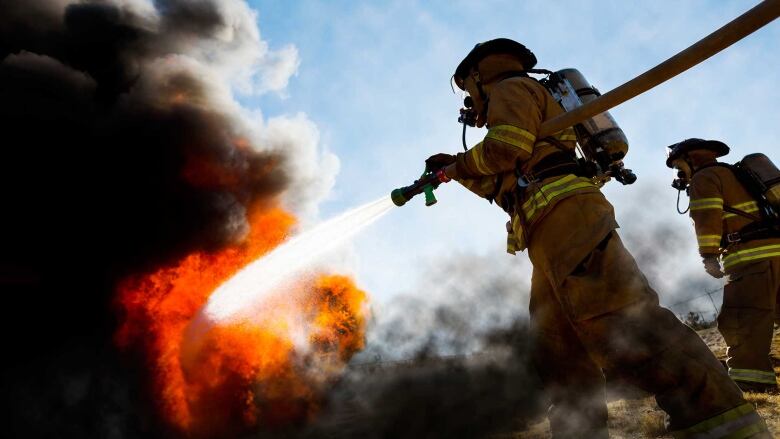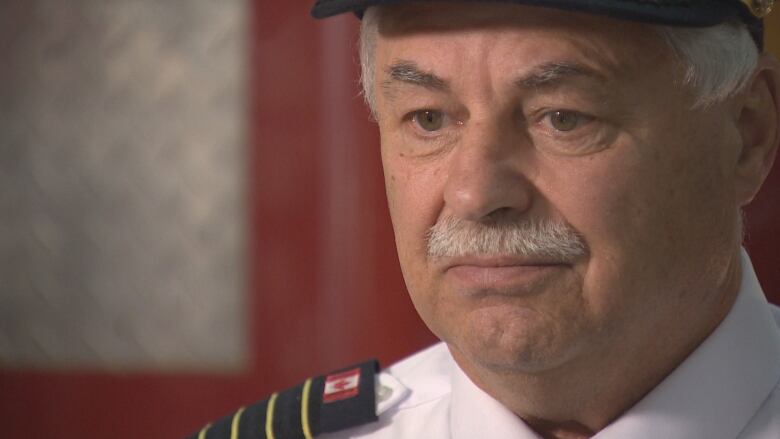Rural fire departments struggle to recruit volunteers, says fire chief
'Something that has such a direct relation to life safety and to saving people's homes needs to be a priority'

A New Brunswick fire chief says there aren't enough volunteer firefighters to battle house fires or respond to motor vehicle crashes in rural areas, particularly during the work week.
For years Justin McGuigan, fire chief of the North York Fire Department,said the number of firefighters hasdwindled in his region and fire stations are having a harder time recruiting volunteers.
"Everybody can agree more volunteer firefighters are needed, but the problem is the majority of people think that it's somebody else's problem, it's somebody else's job." he said. "They think, 'Well I've got this to do, I've got that to do.'"
This poses a problem for McGuigan and his team of about 25 active firefighters.
"We are migrating in our society toward a "me-focused' frame of mind," he said.
- Volunteer firefighters not impressed when 911 call goes dead
- Volunteer firefighters needed across New Brunswick, fire marshal says
- Moncton-area fire chiefs call for regional live-fire training centre
The North York Fire Department coversKeswickValley and the village of Millville, 57 kilometres northwest of Fredericton.
McGuigan said the biggest sore point with his firefighters is the response they often get when theyask people to try volunteering: too busy.

"It kind of says, 'My time is more important than yours, what I'm doing is more important than what you're doing," he said in an interview with Information Morning Fredericton.
"As a volunteer organization, something that has such a direct relation to life safety and to saving people's homes needs to be a priority."
In the fall of 2017, more than 145 ofthe 167 fire departmentsacross the province reliedon volunteer firefighters.
Myths and trends
Volunteer firefighters have several myths and trends working against them, McGuigansaid.
One of those myths is that there are enough people to provide balanced coverage 24 hours a day throughout the year in rural areas.
Over the past 10 years, the number of volunteer firefighters in the area has declined by 25 per cent, he said.
- Response time questioned after fire rips through Elsipogtog apartment building
- 'The saddest day of our town': Church at heart of Bas-Caraquet destroyed
- 1 person dead after fire erupts at motel near Woodstock
McGuiganwas at home sick whenhis neighbour's house caught fire in the middle of the afternoon.
That day, three shift workers were at home, and a bus driver was still working in the community.The remaining volunteer firefighters were able to stop the fire before it destroyed the house, he said, but 95 per cent of the timethere wouldn't have beenenough staff to battle such a blaze.
"That lady's house would've burned to the ground."
We can't stay home to wait to volunteer as a firefighter.-Justin McGuigan, North York fire chief
McGuigan said it's important for the publicto understand that during the day [in] rural areas, firefighters are left in uncomfortable situations.
"Because we are volunteers, and we need to go to work. We can't stay home to wait to volunteer as a firefighter."
But throughout the day, he said, a department might have to respond to calls up to 50 minutes away because of a shortage of firefighters.
This can lead toburnout among firefighters, who are forced totake time off from volunteering.

A shift of people and jobs from rural areas to more urban centres has also affected firefighting.
"With that migration go the jobs, and so there's less and less work in the rural areas of New Brunswick for some of those firefighters, where they used to be able to work in their area and volunteer, so they'd be close to the fire station," McGuigan said.
Mike Walton, president of the New Brunswick AssociationofFire Chiefs and fire chief of the HartlandFire Department, said people in the workforce are also headingto Western Canada to work, making it more difficult to recruit volunteers.
Trouble maintaining firefighters
Walton said there are 4,500 volunteer firefighters in New Brunswick.
"You're the centre of volunteerism as far as I'm concerned," he said.
While fire crews have a hard time recruiting volunteers, they also have trouble maintaining them.
Fire crews need additional equipmentand some of it can be shared across the province, McGuigan said.
For example, volunteer firefighters are pushing for a mobile, $1 million burn unitand live-fire trainer equipmentto help them practise their skills.
Firefighters nowhave to travel great distances for training and, because of increasingly strictregulations, it's harder for firefighters to train on buildings that have been donated to them, McGuigan said.
A mobile burn unit, he said, "allows us to spend two units of time rather than six units of time to get that training, so the other four units can be used to train on other things and to get our other housework done."

The province has promised $500,000 for the burn unit project last summer, and Walton is in Ottawa this week to seek federal funding for it as well.
"If we had our own, we could train year-roundand offer that to 4,500 firefighters," said Walton, who has been working on the project for the past three years.
CBCNews has asked Michael Lewis, the actingfire marshal, for an interview.
With files from Information Morning Fredericton












_(720p).jpg)


 OFFICIAL HD MUSIC VIDEO.jpg)
.jpg)



























































































